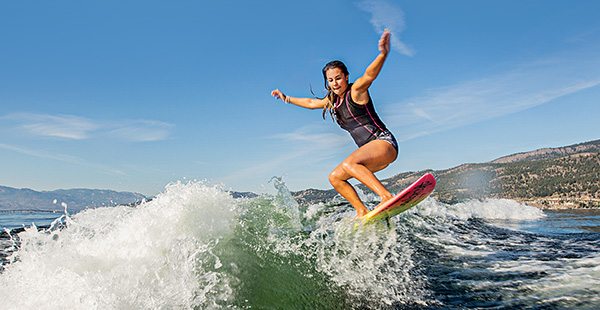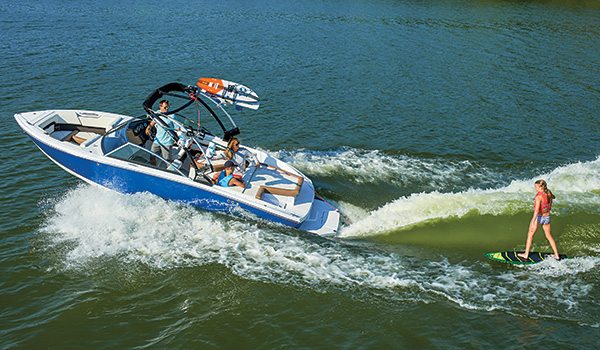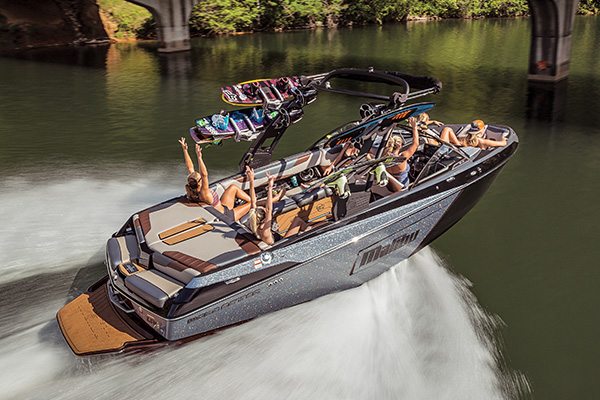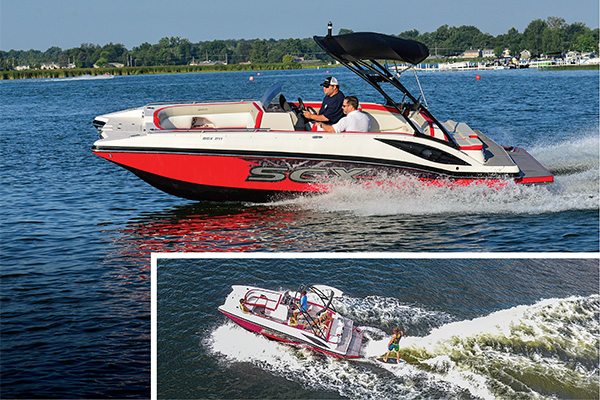Everybody’s gone surfin’…

As the Beach Boys predicted in 1963, everybody’s gone surfin’. But not at the beach – today’s surfers are mostly found playing behind boats. With affordable surf boats and high-end tow boats appealing to a wider range of buyers than ever, the watersports category has never been stronger.
Brian Wilson and The Beach Boys must be feeling more than a bit clairvoyant these days, as a whole new surfing craze sweeps North America. Wake surfing is the biggest thing to hit water sports in decades – so much so that it’s captured the imagination of teenagers and grandparents alike, and given rise to an entire new category of boats and equipment.
“Wake surfing’s appeal lies in that it’s something that anyone can enjoy, and it’s something you do right behind the boat. You’re close enough you can still talk to the people onboard, and interact with the rest of your group. You’re not out there by yourself, 75 feet behind the boat on the end of a rope,” said Steve Huber, marketing assistant at Smoker Craft Inc., manufacturer of seven surf boat models sold under its Starcraft brand. “You’re still connected to your friends and family, and that’s the main reason people go boating in the first place.
“When we exhibit at boat shows today, it’s the one question we get every day. People ask, ‘Can I surf behind this?’ That’s all they want to know,” Huber said.

No question about it – wake surfing is a hot button in today’s boat market, and it’s an activity that appeals to an extremely wide range of boaters.
While advertising images frequently portray wake surfers as pierced and tattooed 20-somethings, in reality the person behind the boat is just as apt to be that 20-something’s parent.
“When we were looking at acquiring Heyday, we kept hearing over and over, it’s a millennial market,” said Bayliner/Heyday President Keith Yunger. “What we learned in our first year in the marketplace is that while we might attract millennials’ attention, the fact of the matter is that most millennials still can’t afford it. They’re trying to pay off a school loan, they’re just starting out in married life with young children and they’re trying to figure out if they’re going to buy a home. They are at a life stage where a boat payment’s simply not in their budget.”
Nevertheless, Yunger said millennials are still interested in boating. More often than not, they grew up with active, boomer parents who do have the financial means and can influence a purchase.
That’s why sales people jump when they’re at a boat show and see a boomer-aged person with a teenager or twenty-something browsing boats, Yunger said.

Surf boats also appeal to active or athletic Gen X buyers who are now established in their career, and who have a jump on starting a family.
“These buyers have reached a stage in life where they now have an entertainment budget. They can go out and explore getting a boat,” Yunger said. So who is the market for surf boats? It could be anyone from a teenager to a retired boomer, because the product has an unusually wide appeal.
Although surfing’s appeal may be broad, the actual buyer is still most likely to be a boomer – at least for now.
“When you surf you’re going maybe one-third the speed that you’re doing when you waterski or wakeboard,” Yunger added. “If you fall, it’s less impactful. We hear comments all the time from buyers, they’re 55 or 60 years old, they used to wakeboard or slalom ski, and now they like to surf because it’s just easier on the body and they don’t feel all stiff and sore the next day.”
Two flavors of surfing
While most manufacturers agree that the surf category should continue to grow over the next 12 to 18 months, efforts to accurately quantify surf boat sales are complicated by the fact that they cross into two distinct categories – traditional inboard-powered tow boats and so-called “surfable sterndrives.”
According to Vicky Yu, director of industry statistics and research with the Chicago-based National Marine Manufacturers Association (NMMA), the inboard-powered tow boat category has demonstrated consistent year-over-year growth in the high single-digit to mid-double-digit range over the past several years. From a base of 4,850 tow boats sold in 2011, the category jumped by more than 13 percent to 5,500 boats sold the following year, followed by a further 11 percent gain to 6,100 boats in 2013.
Tow boat sales grew by another 16 percent in 2014, reaching 7,100 units, followed by further gains of 9.8 percent (to 7,800 units) and 11.5 percent (to 8,700 boats) in 2015 and 2016 respectively.

Although NMMA had not released 2017 data by Boating Industry’s publication deadline, there is no reason to believe that heady trajectory should change any time soon.
While the sterndrive segment hasn’t demonstrated a similar rate of growth overall, sales of Volvo Penta’s Forward Drive product – used in surf boats produced by a number of manufacturers – have grown steadily since its launch in 2015. Volvo Penta’s vice president of marine sales, Jens Bering, said the Forward Drive product currently represents close to 20 percent of the company’s North American sterndrive revenues, with sales continuing to climb every month. Exactly how large that market can grow remains to be seen.
“There was this hardcore group of guys back in the 1990s who really started it, driving two boats side-by-side to create a big wake behind them and then surfing on it,” said John Dorton, former Mastercraft CEO and current president of Bryant Boats. “It was a limited, specialty market that the inboard businesses catered to, dealing with pretty well-heeled folks who wanted the very best and who could afford to spend anywhere from $100,000 and up to get that. When we started working with Volvo on the Forward Drive, we felt there was another market out there where surfing is part of the activity, but not 100 percent of it. We targeted buyers who want to surf some of the time and still have a versatile family runabout. That’s where the Forward Drive works really well, and it quickly gained a lot of traction.”
Volvo Penta’s Forward Drive is frequently credited with opening the door to wake surfing gaining mainstream popularity. Moving the propellers to the forward face of the outdrive and tucking them safely under the boat allowed boat builders to quickly develop surfing versions of existing sterndrive-powered runabouts, minimizing development costs and allowing them to keep retail prices below those of traditional inboard-powered tow boats.
“We know that the surf market for the inboard producers has been strong,” Dorton said. “But we don’t yet know what the right number is for the surfable sterndrive market. We think that given the opportunity, nearly everybody would love to learn how to surf, and we’re just starting to see more and more people becoming exposed to the new technologies that allow you to surf with a more traditional family boat that you can buy at a considerably lower price. I suspect that what you’ll begin to see is more people maybe shifting over from outboards and from inboards into the new surfable sterndrives, because it does provide more versatility than those other two power plants can offer.”
Different strokes
Volvo engines now power a significant percentage of the surf boats sold in North America each year, including products from Campion Marine, Chaparral, Chris-Craft, Cobalt, Four Winns, Monterey, Regal and Starcraft, collectively representing about 40 models in all. Proponents of the system argue buyers can enjoy an excellent surfing wake without giving up the versatility and easy handling of a traditional sterndrive-powered runabout.
“Our four Watersports Edition boats with the Forward Drive let you surf, as well as water ski, tube, wakeboard, fish, or just go for a ride,” said Campion Marine President Brock Elliott. “So you have a boat that will do a lot of different things, as well as produce a wonderful surfing wake. The handling is second to none, anyone can back the boat into the dock with ease, and they can handle rough water when they need to. They don’t suffer the limitations that exist with traditional tow boats.”

Forward Drive advocates also argue that their new generation surf boats cost less than those with traditional inboard power. One might think the appearance of a lower-priced competitor would raise concern among manufacturers of traditional, inboard-powered tow boats, but to the contrary, the development of Forward Drive surf boats has benefitted all manufacturers, said Mastercraft President Terry McNew. “We’re thrilled that Volvo’s forward-facing drive is being adopted by more builders. The forward-facing props on the Forward Drive are safe to surf behind, and that system connects with buyers that we probably wouldn’t reach on our own.”
For tow boat manufacturers like Mastercraft, sterndrive-powered surf boats can represent a pipeline of potential new customers.
“What happens is that people get into it and they start getting more serious about surfing. And after a while they find that they want a bigger, longer, crisper wave,” McNew said. “Having spent 23 years in the sterndrive business at Brunswick, I’ll tell you that you simply can’t achieve that while dragging a sterndrive through the water, it’s a matter of physics. To get that premium wake, you need an inboard. So for those people who want that experience and to have the very best, they can start surfing with a sterndrive boat and then move up to an inboard.”
Malibu Boats CEO Jack Springer agrees that buyers of sterndrive-powered surf boats and inboard-powered surf boats are motivated by completely different criteria. “We believed that sterndrive-powered surf boats would become a feeder system to tow boats and that seems to be the way things are working out,” Springer said. “They represent a great product to get people interested in surfing and raise the profile of this activity. But surfing behind one of them is a different experience, because they don’t capture all the factors that go into a tow boat.”
That’s a situation that could change to some degree over the next few years as more tow boat manufacturers diversify by acquiring additional fiberglass brands that happen to build surf boat product – as Correct Craft did when it acquired Bryant Boats in January 2017, and as Malibu did when it purchased Cobalt last July.

The opportunity to subsequently leverage intellectual property between brands, and grow the value of branded technology, can only lead to rapid development within the category.
“Right now our attention is on Cobalt because they’ve been bringing out two to three new products a year, and my view is that it needs to be more than that,” Springer said. “Some of that development will be focused on growing the surf product, naturally.”
The other way builders can grow their branded technologies is through licensing agreements.
“We caught a lot of people off guard when we came to the agreement to allow Chaparral to use the Surf Gate branding and type of product,” Springer added. “What we’ve seen is now when you go into a boat show you see Surf Gate signs everywhere. When you read their ads and boat tests in magazines, it says ‘Powered by Surf Gate by Malibu.’ So the credit we get for that makes people naturally gravitate toward Malibu when the time comes to move up to an inboard-powered tow boat.”
With all manufacturers investing heavily in R&D, both sterndrive-powered surf boats and traditional inboard-powered tow boats will improve over time, potentially narrowing that performance gap for at least some buyers. But regardless of the mechanics involved, the potential growth for the surf boat category overall is considerable.
“No one knows how big it’s going to get,” Huber said. “But surfing has a really wide appeal. It’s a lot of fun, and it’s something that anyone can enjoy. In that sense it’s unique, because you can have kids, their parents, and their grandparents all taking a turn behind the boat and having a great time together on the water. Surfing is keeping a lot of people in boating, instead of hanging it up and taking up golf, and that’s a very good thing for all of us.”




